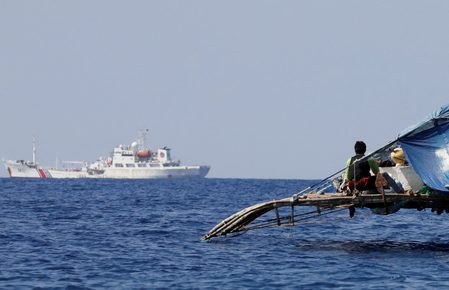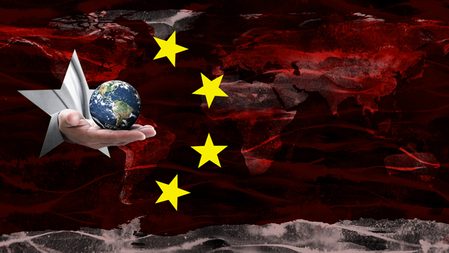SUMMARY
This is AI generated summarization, which may have errors. For context, always refer to the full article.
![[ANALYSIS] China’s artificial island building: Implications on security, stability, and peace](https://www.rappler.com/tachyon/2022/10/Screen-Shot-2022-10-23-at-12.12.42-PM.png)
The following is a speech delivered by retired Senior Supreme Court Justice Antonio T. Carpio at a webinar on the topic, “China’s Artificial Island Building in the Spratlys” held on October 22, 2022 to celebrate the 7th Anniversary of the National Youth Movement for the West Philippine Sea.
China reclaimed seven geologic features in the Spratlys from December 2013 to October 2015. Four of these seven geologic features are high-tide features and three are low-tide features. Under the United Nations Convention on the Law of the Sea or UNCLOS, high-tide features – referring to geologic features that are above water at high tide – are subject to claims of sovereignty. High-tide features have their own territorial sea.
Low-tide features – or geologic features which are submerged at high tide and situated beyond any territorial sea – are not subject to claims of sovereignty. Low-tide features situated beyond the territorial sea have no territorial sea of their own.
One of the three low-tide features reclaimed by China is Subi Reef which in its original natural state was fully submerged at high-tide but is now a 394-hectare artificial island. The Hague arbitral tribunal ruled that Subi Reef is within the territorial sea of a high-tide feature: Pagasa. Pagasa is occupied by the Philippines which is the coastal state exercising sovereignty over Pagasa. Under international law, only the coastal state, in this case the Philippines, has the sovereign right to create an artificial island in Subi Reef, which to repeat is within the territorial sea of Pagasa. Consequently, China’s artificial island in Subi Reef is illegal as its construction violates international law.
The second low-tide feature reclaimed by China is Mischief Reef, which in its original natural state was fully submerged at high tide as ruled by the Hague arbitral tribunal but is now a 558-hectare artificial island. Mischief Reef is beyond the territorial sea of any high-tide feature but is within the Exclusive Economic Zone (EEZ) of the Philippines as ruled by the Hague arbitral tribunal. Under UNCLOS, only the coastal state, in this case the Philippines, has the exclusive right to create an artificial island within its EEZ. Consequently, China’s artificial island in Mischief Reef is illegal as its construction violates UNCLOS.
The third low-tide feature reclaimed by China is Hughes Reef which in its original natural state was fully submerged at high tide as ruled by the Hague arbitral tribunal. Hughes Reef is now a 7.6-hectare artificial island. Hughes Reef, being beyond the territorial sea of any high-tide feature, falls within the EEZ of the Philippines and thus its reclamation by China into an artificial island is illegal under UNCLOS. China erected on Hughes Reef a tall communications tower topped with a radome. China fortified the buildings on Hughes Reef with gun emplacements.
The construction of China’s artificial islands in Subi Reef, Mischief Reef, and Hughes Reef, in patent violation of international law and UNCLOS, obviously disturbs the security, stability, and peace in the South China Sea. More so when we consider the clear intent of China in creating these artificial islands, which is to enforce China’s invalid nine-dash line as China’s national boundary in the South China Sea. These artificial islands host military structures, with Subi Reef and Mischief Reef hosting huge air and naval bases, complete with three-kilometer long runways for all kinds of military aircraft as well as deep harbors for warships like frigates and destroyers. These air and naval bases are defended with anti-ship and anti-aircraft missiles.
China’s new coast guard law authorizes its coast guard to fire on foreign vessels that infringe on China’s claimed jurisdiction under its nine-dash line, even if the foreign vessels are navigating beyond China’s territorial sea, EEZ, or extended continental shelf. This is a clear violation of the UN Nations Charter, which prohibits and outlaws the use of force to settle territorial or maritime disputes. Under the UN Charter, such disputes between or among states must be settled peacefully thru negotiation, mediation, or arbitration.
China’s new coast guard law also clearly violates UNCLOS which recognizes freedom of navigation and overflight, including the conduct of naval drills, in the EEZ and high seas. Under international law and UNCLOS, the high seas in the South China Sea, occupying about 25% of the total maritime area of the South China Sea, belong to all mankind as part of the global commons. China, however, is claiming the highs seas in the South China Sea as its own because they fall within China’s nine-dash line.
China’s nine-dash claim, declared invalid and illegal by the Hague arbitral tribunal, is now being enforced by China under its new coast guard law that clearly and openly violates the UN Charter and international law. The huge artificial islands created by China in Subi Reef and Mischief Reef, declared by the Hague arbitral tribunal as unlawfully created by China for being in violation of UNCLOS, are the air and naval bases that China will use to enforce its invalid and illegal nine-dash line claim.
In short, first, China under its nine-dash line illegally claimed most of the South China Sea. Then China illegally created artificial islands in the South China Sea and militarize these islands. Now, China is using these illegally created islands to enforce thru illegal means China’s illegal nine-dash line. China is tripling down on its brazen drive to reshape the world order to accommodate its hegemonic ambitions.
These acts of impunity by China disturb not only the security, stability, and peace of the South China Sea but also of the entire world because China is actually attempting to replace the rule of law under the UN Charter with the rule of the naval canon and cruise missiles. For China, might is right and not right is might. If China succeeds in reshaping the international legal order, the world will revert to the situation before the adoption of the UN Charter, a period when wars were legitimate means of acquiring territory or maritime zones, and when wars were always lawful for the aggressors if they become the victors.
If China succeeds in replacing the fundamental rule under the UN Charter that right is might with the rule that might is right, the world will enter into another period of never-ending wars, which one day will likely lead to the use of nuclear weapons. That would mean the end of mankind as we know it.
That is why all those concerned with the future of mankind must oppose any attempt by China, or by any state for that matter, to replace or even undermine the fundamental UN Charter principle that all disputes between or among states must be settled peacefully thru negotiation, mediation or arbitration. The UN Charter must continue to prohibit and outlaw the use of force to settle territorial or maritime disputes. This is the only way we can save our world, and mankind, from a catastrophic man-made destruction from which the world may never recover. – Rappler.com
Add a comment
How does this make you feel?









![[OPINION] Expectations for Philippines-US-Japan trilateral cooperation: A view from Japan](https://www.rappler.com/tachyon/2024/04/tl-ph-usa-jp-cooperation.jpg?resize=257%2C257&crop=447px%2C0px%2C1080px%2C1080px)











![[Just Saying] SONA 2024: Some disturbing points](https://www.rappler.com/tachyon/2024/07/TL-marcos-sona-points-july-23-2024.jpg?resize=257%2C257&crop=335px%2C0px%2C720px%2C720px)

There are no comments yet. Add your comment to start the conversation.